Shop By Category
- Esigenze
- On Sale
- Violin Making Molds
- Wood for String Instruments
- Tools for Musical Instruments
- Luthier Accessories
- Bow Making
- Guitar Making
- Restoration
- Varnish
- Workshop
- Strings & Accessories
- Supplies for schools
- Supplies
- All manufacturers
- 3M
- Aburatsubo
- Aka
- Akusticus
- arkansas
- Arno
- Awasedo
- Ballistol
- Barsa Bridges
- Belgian Stone
- Bender
- Bernardel
- Bessey
- Binsui
- Bochem
- Bogaro & Clemente
- Borciani & Bonazzi
- Bridge City
- By Henry Strobel
- Cag
- CD Juwel
- Cerax
- Chisaka
- Corradi
- Cremonabooks
- Creusen
- Crown Tools
- Cryo technology
- D-Kumi Nomi
- Dastra
- Dick
- Dictum
- DMT
- Dremel
- Dubuque
- Due ciliegie
- ETERNA
- FISCH
- Gerhò
- Gewa
- Girmi
- GL
- Grandi Liutai Italiani
- Grip-On
- Gruschwitz
- Gundel-Putz
- GYOKUCHO
- Habico
- HAMMERL
- Hatagane
- Hattori
- Henry Taylor
- Herdim
- Heriba
- Hill & Sons
- Hock
- Honstar
- HOSCO
- Ibex
- Isi Sharp
- Italchimici
- Jende
- Jinzo
- Jo-Haku
- Jorgensen
- JUUMA
- JUZEK - Käfer
- Klemmsia
- Kogatana
- KOVAX
- KREMER
- Kunsuto
- KUNZ
- Kyocera
- Larsen
- Lefranc & Bourgeois
- LENZNER
- Lie-nelsen
- Luban
- M Power Tools
- MAG-ic Probe
- Maimeri
- METRICA
- Micro-Surface
- Millant
- Mirka
- Missarka
- MOORE&WRIGHT
- Multi - Lite
- Nagura
- Naniwa
- Nano Hone Sharp Skate
- Narex
- Norton
- NT Dresser
- Old Wood
- One Way
- Pegas
- Permetar
- PetzVienna
- Pfeil
- Picreator
- Piher
- Pirastro - GMBH
- Pony
- Pride Abrasive
- Produttore di test
- Rakso
- Rubner
- Schröder
- SciesMiniatures
- Scrollavezza
- Shapton
- Shinko
- Shinto
- Shinwa
- Sho-Honyama
- Sia abrasive
- Sinensis
- Sintoms
- Sjöbergs
- Sorby
- Spreader Clamps
- Stanley
- Stradpet
- Stubai
- Suehiro
- Summit
- Tataki Nomi
- Teller
- The Strad
- Thomastik-Infeld
- Tido
- Titebond
- Tormek
- Trade King Mark
- Tsushima
- Ulssberger
- Uo-Chikyu
- V.C.I. Anti-Rust Paper
- Vallorbe Glardon
- Vallorbe swiss
- Veritas
- Victorinox
- Viki
- Viva la Musica
- Weicon
- Wiha
- Winsor & Newton
- Wittner
Best Sellers
Best Sellers
Grandi Liutai Italiani,
5/
5
<p> Purflings for string instruments </p>
<h3>Our evaluation of the Fillets for String Instruments available in various materials and sizes</h3>
<p>The Fillets for String Instruments available in various materials and sizes have been carefully evaluated by our team of experts at Grandi Liutai and represent an excellent choice for luthiers seeking high-quality fillets for their string instruments. These fillets are available in a variety of materials, such as ivory, ebony, and mother-of-pearl, and in different sizes to accommodate the diverse needs of the instruments. Fillets for string instruments are essential components for the construction and repair of violins, violas, and cellos, as they provide an aesthetic touch and contribute to the strength and durability of the instruments. We are pleased to confirm that the fillets for string instruments available at Grandi Liutai are of the highest quality and meet the highest standards. The variety of materials available allows luthiers to choose the material that best suits their aesthetic preferences and project specifications. Ivory, for example, offers a classic and refined look, while ebony adds an elegant touch, and mother-of-pearl adds a hint of shimmer. Regardless of the chosen material, the fillets are made from top-quality materials, ensuring optimal strength and long-term durability. The different sizes available allow luthiers to tailor the fillets to the specific dimensions of their instruments. This allows for a seamless integration of the fillets into the overall aesthetics of the instrument and facilitates easier handling and application. We particularly appreciate the craftsmanship quality of the fillets for string instruments available at Grandi Liutai. They are meticulously handmade with great attention to detail, ensuring impeccable precision in their crafting and application. Additionally, their compatibility with various types of varnishes and finishes allows for a uniform and professional instrument finish. In summary, the Fillets for String Instruments available in various materials and sizes at Grandi Liutai are an excellent choice for luthiers seeking high-quality fillets for their instruments. The variety of materials and sizes, along with the craftsmanship quality and compatibility with different finishes, make them a versatile and reliable solution for the construction and repair of string instruments. We highly recommend the fillets for string instruments from Grandi Liutai to all luthiers seeking high-quality materials for their projects.</p>
038.001
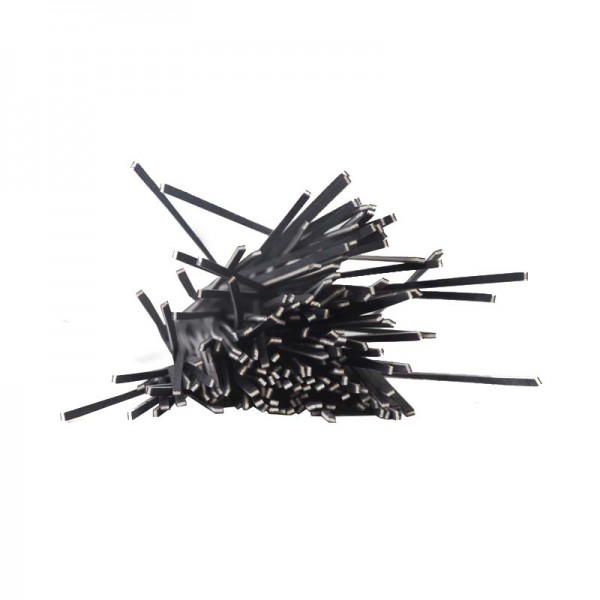 Purfling for...
Purfling for...
€1.20
Grandi Liutai Italiani,
5/
5
<p>Corundum sandpaper applied with an electrostatic process and bonded with synthetic resin.</p>
<p>Universal paper for solid wood, for sanding varnishes and colours, primers and fillers and for intermediate sanding of paints, very high removal force, does not crumble thanks to the special coating and excellent finish.</p>
<p>Thanks to its high flexibility it ensures easy sanding on edges and corners.</p>
031.056
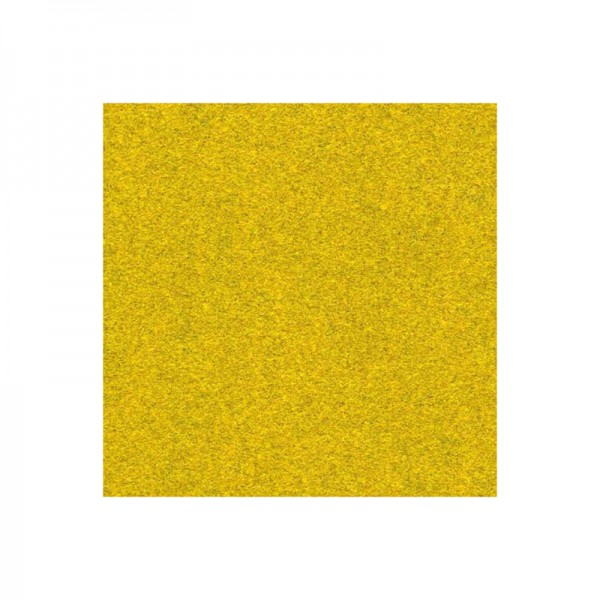 Siarexx Cut Sand Paper -...
Siarexx Cut Sand Paper -...
€0.80
Grandi Liutai Italiani,
5/
5
<h2>Internal italian molds violin</h2>
<p>The mold of the violin is always the starting point for a professional instrument. All the production and design of the mold of the <em>Academia Cremonensis</em> is rigorously carried out in Cremona, where expert luthiers reproduce the forms of the past, in order to guarantee the quality of each kit. This Deluxe Pattern set includes an inside mold that is 15mm thick made of 11 birch ply wood. The set contains all templates for plate outline, neck (scroll) template, f-hole template including the f-hole position, upper and lower blocks, corner blocks and complete arching templates for top and back. Also included is a brief history of the maker and model with a color photo.</p>
<p>Violin inside <strong>molds Cremonese Kit</strong> Contains:</p>
<ul style="list-style-type:disc;">
<li>violin silhouette template</li>
<li>scroll model</li>
<li>handle with peg holes</li>
<li>model of the effe including the placement mark</li>
<li>model of the upper and lower blocks, of the points</li>
<li>models of the arching complete with top and bottom</li>
</ul>
<h3>Kit Cremonese molds</h3>
<ul style="list-style-type:disc;">
<li>Antonio Stradivari 1715 Cremonese </li>
<li>Antonio Stradivari 1716 Messiah</li>
<li>Giuseppe Guarneri del Gesu' 1733 Kreisler</li>
<li>Giuseppe Guarneri del Gesu' 1743 Cannone</li>
<li>Nicolò Amati 1649 Alard</li>
</ul>
<p><iframe width="250" height="250" src="https://www.youtube.com/embed/F96tAeU2g5Q" frameborder="0"></iframe></p>
010.001
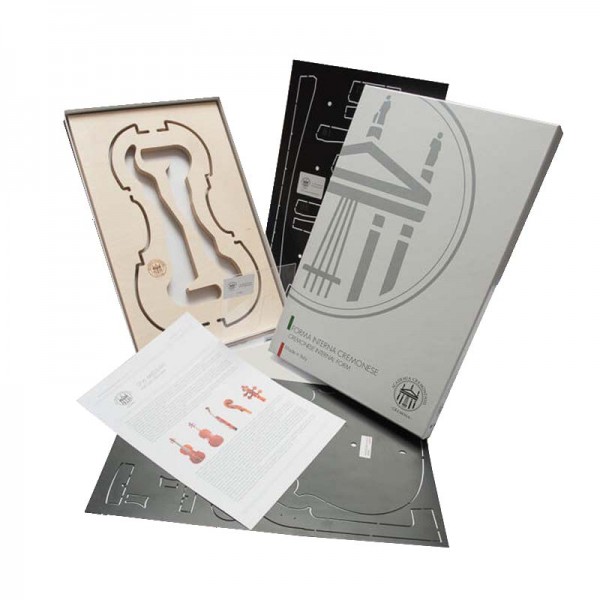 Violin Italian Molds Kit
Violin Italian Molds Kit
€149.90
Grandi Liutai Italiani,
5/
5
<p class="MsoNormal"><span lang="en-us" xml:lang="en-us">The finest quality smoothing and polishing material </span></p>
<p></p>
<p><span lang="en-us" style="font-size:11pt;line-height:107%;font-family:Calibri, 'sans-serif';" xml:lang="en-us">Micro-Mesh is excellent for intermediate sanding between coats of paint, retouching and fine finishing work on wood, plastic, plexiglass, and metal surfaces, including polishing. For irregular and curved surfaces also. The abrasive particles are suspended in a silicon matrix strongly bound to a thin, highly flexible textile basis, so that no residual remain on the finished surface. Micro-Mesh can be used dry, with water, or with petroleum, and is very long-lasting under normal wear.</span></p>
031.001
 MICRO-MESH - 80mm x 15,3cm
MICRO-MESH - 80mm x 15,3cm
€3.20
Grandi Liutai Italiani,
5/
5
<p>Standard block plane 20°. For heavier cuts with the grain. Bevel angle 25°. Results in a normal cutting angle of 45°.</p>
<p>PM-V11 Steel</p>
<p>PM-V11 steel is made from a new, powder metallurgy steel alloy. With its ultra-fine and homogeneous material structure and extreme hardness (HRC 61-63), this steel has double the edge-retention capacity of A2 steel. The extremely hard-wearing blades allow a razor-sharp edge and are highly durable even at a bevel angle of less than 20°. All blades come with a 2° microbevel and can be sharpened on conventional waterstones.</p>
<p>Compact all-round plane for fine shavings. The mouth opening can be adjusted according to the application, using the configurable shoe (for removing thick or thin shavings). The indentations in the sides make it easier to guide this handy plane accurately. Central setscrew for blade depth and lateral adjustment. Please note: The plane is supplied in two parts (plane body and blade).</p>
<p>Veritas Planes</p>
<p>The corporate philosophy of Canadian tool manufacturer Veritas aims to develop new adjustment mechanisms and enhance historic plane design. With bodies made of stress-relieved spheroidal cast iron, these tools are highly resistant to cracking and distortion. Their soles are perfectly plane and trued at right angles to the sides. Their thick blades of high-strength A2 steel are hardened to 60-62 HRC and additionally subjected to a special low-temperature process to achieve a finer grain. Veritas planes are optionally available with PM-V11 blades. (The Custom series models are equipped with PM-V11 blades as standard). Two setscrews on the sides constrain the blade laterally, keeping it in place regardless of the type of stress applied. Unless otherwise stated, the blade is angled at 45°. With their material combination of finely-ground or black-coated cast iron bodies, polished brass setscrews and beautiful torrefied maple handles, these planes are also pleasing to the eye</p>
<p>Blade material PM-V11™</p>
<p>Blade width 41 mm</p>
<p>Blade thickness 3.2 mm</p>
<p>Overall length 160 mm</p>
<p>Weight 800 g</p>
<p>Blade angle 20 °</p>
<p></p>
023.020
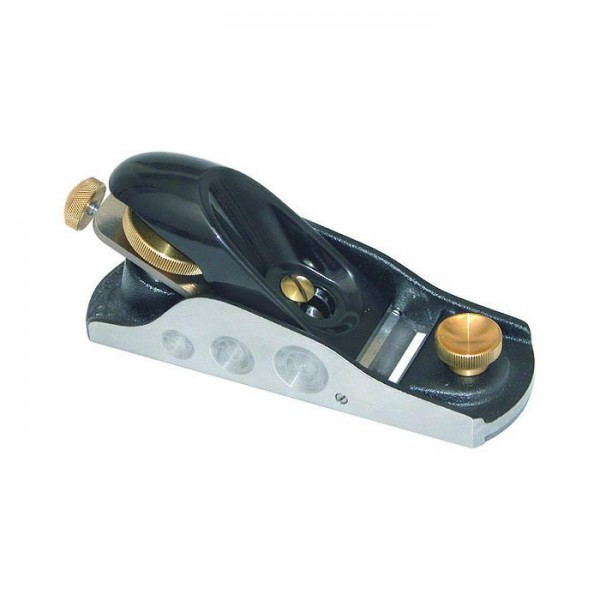 VERITAS Block Plane PM-V11®
VERITAS Block Plane PM-V11®
€269.90
Grandi Liutai Italiani,
5/
5
<p class="MsoNormal"><span lang="en-gb" xml:lang="en-gb">Grandi Liutai Italiani carries the finest quality of Platinum shellac available and guarantee its as the best quality on the market.</span></p>
<p>Shellac is the purified, processed crude Seedlac.</p>
<p>Dewaxed Platinum Shellac Flakes has very little colour.<span> </span>It is primarily used as a clear coat in order to reveal the natural colour of the wood. It allows the natural colour to show through.</p>
<p>It has a wonderful clarity and depth of shine.<span> </span>It will produce one of the most beautiful finishes in violinmaking. Platinum is one of the most popular colours for bringing out the natural colour of exotic hardwoods.<span> </span>Platinum Shellac gives the wood a little amber colour and is the 1st lightest colour available on the market.</p>
<h3>Our evaluation of Shellac Platinum BLEACHED</h3>
<p>Dewaxed and Decolored Shellac Recently, the team of <strong>Grandi Liutai</strong> evaluated Platinum BLEACHED Dewaxed and Decolored Shellac for the preparation of varnishes and lacquers, as well as for the protection of furniture and musical instruments. After a series of tests conducted in our luthier laboratories, we can confidently say that it is a high-quality product. Firstly, our company noticed that Platinum BLEACHED Dewaxed and Decolored Shellac comes in the form of a solid, transparent resin with a pale color. Its easy-to-work-with consistency and ability to harden quickly make it ideal for preparing varnishes and lacquers. Furthermore, our team found that this dewaxed and decolored shellac has significant solubility, making it easy to dilute in solvents such as alcohol or turpentine to create high-quality varnishes and lacquers. Secondly, we tested Platinum BLEACHED Dewaxed and Decolored Shellac for the protection of furniture and musical instruments. Its transparency and ability to harden quickly provide long-term protection against wear and tear. Additionally, we noted that this decolored and dewaxed shellac is resistant to stains, moisture, and UV rays, making it ideal for protecting objects exposed to direct sunlight. Finally, we appreciated the versatility of Platinum BLEACHED Dewaxed and Decolored Shellac. This product can be used not only for the preparation of varnishes and lacquers but also for the creation of craft and decorative objects, such as frames or boxes. Its ability to preserve the natural color of wood and provide a glossy and durable finish makes it an essential tool for any artisan. In conclusion, the<strong> evaluation by the Grandi Liutai team</strong> of Platinum BLEACHED Dewaxed and Decolored Shellac is <strong>extremely positive</strong>. Its high quality, ease of use, and versatility make it an indispensable product for any luthier or artisan. We highly recommend this product to anyone in need of preparing high-quality varnishes and lacquers or protecting and decorating wooden objects.</p>
045.100
 Shellac Platinum Bleached...
Shellac Platinum Bleached...
€9.90
Grandi Liutai Italiani,
5/
5
<p>Top Quality African Ebony. Thickness is sufficient for restoration work or on new instruments. Pre-shaped and ready for easy, final shaping and fitting.</p>
013.010
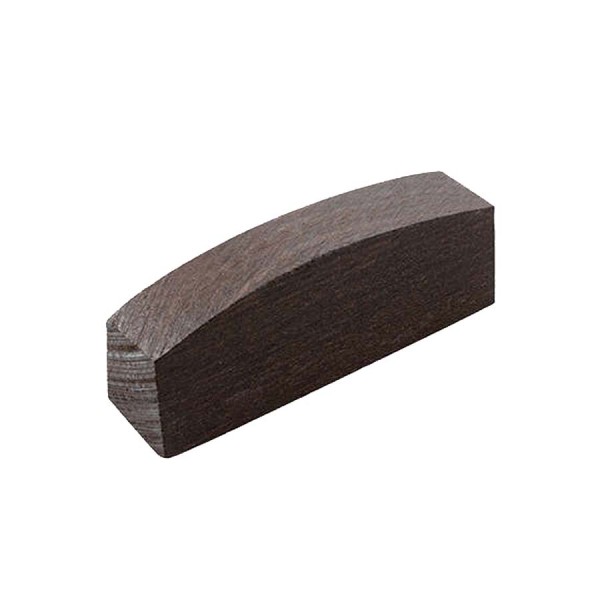 Violin Nut, Shaped
Violin Nut, Shaped
€0.90
Grandi Liutai Italiani,
5/
5
<h2 class="MsoNormal"><span>Amber for the preparation of oil paints</span></h2>
<p class="MsoNormal"><span>The <strong>Amber Colophony</strong> is prepared by exposing Amber to a short-term temperature which occurs in vacuum, coupled with the simultaneous separation of the gaseous and liquid elimination products, results in the formation of a particularly high-quality rosin which is free from extraneous substances and is particularly suitable for the production of oil varnishes. </span><span lang="it" xml:lang="it">The reaction takes place at 300-450 Celsius.</span></p>
<h3 class="MsoNormal"><span lang="it" xml:lang="it">It is above all indicated for the production of high quality varnishes in lutherie</span></h3>
<h3>Our evaluation on the use of <strong style="font-size:11px;">amber Colophony</strong></h3>
<p><span style="font-size:11px;">At </span><strong style="font-size:11px;">Grandi Liutai</strong><span style="font-size:11px;">, we have </span><strong style="font-size:11px;">evaluated the use</strong><span style="font-size:11px;"> of</span><strong style="font-size:11px;"> amber Colophony</strong><span style="font-size:11px;"> and found that its main function is to confer greater resistance and hardness to the paint, while also improving its adhesion. However, the use of </span><strong style="font-size:11px;">amber Colophony</strong><span style="font-size:11px;"> in the preparation of oil paints presents some unique characteristics. Firstly, it is necessary to have a reliable source of high-quality amber, as its purity and properties can vary significantly. We have found that the processing of </span><strong style="font-size:11px;">amber Colophony</strong><span style="font-size:11px;"> can be complicated and require the use of specialized equipment. Despite these disadvantages, we have seen that the use of pyrolyzed amber can bring numerous advantages in the preparation of high-quality oil paints. Paints containing pyrolyzed amber have greater wear resistance, adhesion, and durability over traditional oil paints. In addition, </span><strong style="font-size:11px;">amber Colophony</strong><span style="font-size:11px;"> can improve the transparency and brightness of the paint, giving paintings a more vibrant and brilliant appearance. In summary, Grandi Liutai is satisfied with the use of </span><strong style="font-size:11px;">amber Colophony</strong><span style="font-size:11px;"> in the preparation of oil paints, which may require some attention and expertise but can lead to extremely satisfying results. When used correctly, </span><strong style="font-size:11px;">amber Colophony</strong><span style="font-size:11px;"> can significantly improve the quality and durability of oil paints, giving paintings a more vibrant, brilliant, and long-lasting appearance.</span></p>
045.103
 Amber Colophony - 100 g
Amber Colophony - 100 g
€16.90
List of products by brand Isi Sharp
Isi Sharp online shop: Professional tools
Showing 1-1 of 1 item(s)
Active filters
-
Grandi Liutai Italiani,5/ 5<p>This set of ISI SHARP chisels is a solid basic equipment for every woodworker. The carbon steel blade (T10) is hardened to 61 - 63 HRC. The ash handles are without impact ring, so that the irons can be more comfortably guided by hand or struck with the heel of the hand. Even without an impact ring, the ash handles can withstand light to medium blows with a mallet. The handles have a colorless matte finish and are slightly flattened on two sides to prevent rolling.</p> <p></p> <p>Iron widths in the set: 6, 10, 12, 16, 20, 26 mm</p> <p>Bevel angle 25°</p> <p>Total length, depending on blade width 250 to 270 mm</p> <p>Blade length measured without tang, depending on blade width 97 to 105 mm</p> <p>Handle diameter 29 mm</p> <p>In Original wooden case</p> <p></p> <p>The Patented ISI SHARP:</p> <p>The face of a chisel must be flat in order to make precise wood joints. Most woodworkers are familiar with this fact. However, you may have experienced that it is not so easy to produce or maintain such a precise face on Western chisels.</p> <p></p> <p>The face of a Western chisel is relatively long, usually between 100 and 120 mm. When the entire length of the mirror side is honed on a flat waterstone, it bumps and lifts at the transition to the tang. At this moment, the honing stone has contact with the iron only at the cutting edge and at the tang. This means that the objective of achieving a flat mirror surface is not realized. In practice, therefore, only the part of the face close to the cutting edge is honed. However, it cannot be avoided that the face of the mirror becomes rounded over time, since there is no defined end of the grinding surface towards the tang side. Precise work is therefore only possible to a limited extent.</p> <p></p> <p>Why do Japanese chisels not have this problem? The face of Japanese chisels is short, often only 60 to 70 mm. In addition, due to single or multiple hollow grinding (Ura) of the face of the chisel, the area that has to be removed is considerably reduced. The third and decisive advantage is that the tang is angled with respect to the longitudinal axis of the face of the iron. This means that the sharpening or honing stone only touches the surface of the mirror side, which is limited on all sides. The result is a permanently flat mirror side.</p> <p></p> <p>The basic idea behind the isi sharp chisels is to transfer this advantage of Japanese chisels to Western chisels.</p> <p></p> <p>First of all, the question remains to be answered as to why Japanese chisels are not used instead of Western chisels. The answer: Many Western woodworkers find the Japanese chisels too short. Not everyone likes to get used to the angled handle.</p> <p></p> <p>The face of the isi sharp chisel chisel4 is designed as a flat surface in its part close to the cutting edge up to a length of approx. 70 mm. The novel feature is that the remaining surface is recessed by 0.5 to 0.6 mm up to the tang. This means that the surface to be ground is clearly defined on all 4 sides and reduced to the length of a Japanese chisel. This also means that the result is a permanently flat face of the chisel. This invention originates from Friedrich Kollenrott and is registered as a utility model at the German Patent Office.</p> <p></p>025.312
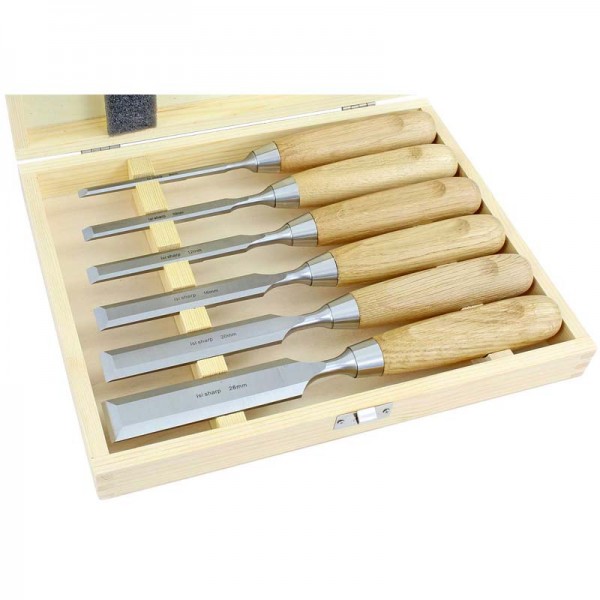
Set of 6 patented chisels ISI SHARP Friedrich Kollenrott
€105.90











